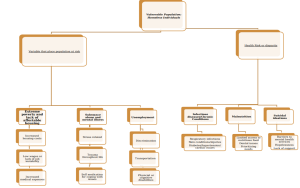NR 586 Week 2 Concept Map- Homelessness
Student Name
Chamberlain University
NR-586: Population Health and Epidemiology for Advanced Nursing Practice
Prof. Name:
Date

Vulnerable Population: Homeless Individuals
Homeless individuals represent a highly vulnerable population due to various risk factors that contribute to their instability and poor health outcomes. One of the primary variables placing this population at risk is extreme poverty and the lack of affordable housing. With increasing housing costs and low wages, many individuals struggle to secure stable employment, leading to job instability or unemployment. Additionally, the burden of increased medical expenses, coupled with substance abuse and mental illness, further exacerbates their situation. Many homeless individuals experience significant stress and trauma throughout their lives, often resorting to self-medication as a coping mechanism. Discrimination, limited transportation options, and physical or cognitive disabilities further restrict their ability to access essential services and employment opportunities.
The health risks and disparities faced by homeless individuals are severe and multifaceted. They are highly susceptible to infectious diseases and chronic conditions, such as respiratory infections, skin conditions, diabetes, hypertension, and cardiac issues. Malnutrition is a common concern due to limited access to nutritious food, leading to additional health complications. Poor dental hygiene and untreated dental issues are also prevalent, as individuals may prioritize immediate survival needs over oral health care. Mental health challenges, including suicidal ideation and barriers to accessing mental health services, further compound their vulnerability. Feelings of hopelessness and the lack of a support system often result in worsening health outcomes and difficulty in breaking the cycle of homelessness.
Table Format
| Category | Risk Factors | Health Risks/Disparities |
|---|---|---|
| Economic and Social Risks | Extreme poverty, lack of affordable housing, increased housing costs, low wages, job instability, unemployment, discrimination, limited transportation | Increased medical expenses, limited access to nutritious food, prioritization of survival needs over healthcare |
| Psychological and Behavioral Risks | Substance abuse, mental illness, stress-related trauma, self-medication, lack of support system | Suicidal ideation, barriers to mental health services, feelings of hopelessness |
| Physical Health Risks | Physical or cognitive disabilities, exposure to harsh environmental conditions | Infectious diseases, respiratory infections, skin conditions, diabetes, hypertension, cardiac issues, malnutrition, dental problems |
References
National Alliance to End Homelessness. (2023). State of homelessness: 2023 edition. https://endhomelessness.org/
Substance Abuse and Mental Health Services Administration. (2022). Behavioral health among people experiencing homelessness. https://www.samhsa.gov/
World Health Organization. (2022). Health and homelessness. https://www.who.int/
Post Categories
Tags
- Annotated Bibliography (2)
- Bioinformatics (1)
- Budget Negotiations (1)
- Capital Budget (1)
- Capstone Video Reflection (1)
- Care Coordination (6)
- Community Health Care (1)
- Community Health Needs (1)
- Community Resources (2)
- Complaint Analysis (4)
- Concept Map (2)
- Curriculum Evaluation (1)
- Curriculum Overview (1)
- Dashboard Metrics Evaluation (1)
- Descriptive Statistics (1)
- Disaster Plan (1)
- Educational Technology (4)
- Enhancing Quality and Safety (1)
- Environmental Analysis (1)
- Evaluating Technology Usage (1)
- Evaluation Plan Design (1)
- Evidence and Resources (1)
- Evidence Based Approach (1)
- Evidence Based Care (1)
- Evidence-Based Change (1)
- Evidence-based Practice (1)
- Evidenced-Based Literature (2)
- Executive Summary (1)
- Exploration of Regulations (1)
- Final Project Submission (1)
- Global Issue (1)
- Health Care (3)
- Health Care Professional (1)
- Health Improvement Plan (1)
- Health Policy Proposal (1)
- Health Promotion Plan (3)
- Healthcare Improvement (2)
- Implementation Plan (2)
- Interdisciplinary Issue Identification (1)
- Interdisciplinary Plan Proposal (1)
- Intervention Strategy (1)
- Leadership and Group Collaboration (2)
- Leadership Reflection Video (1)
- Legal and Ethical Issues (1)
- Literature Review (1)
- Literature Search (1)
- Literature Synthesis (1)
- Managing the Toxic Leader (1)
- Manuscript for Publication (1)
- Media Submission (1)
- Meeting with Stakeholders (1)
- Mentor Interview (1)
- MSN Reflection (1)
- Near-Miss Analysis (1)
- Nurse Educator (1)
- Obesity (2)
- Ontological Humility (1)
- Organizational Change (1)
- Outcome Measures (1)
- Outcomes of the Intervention (1)
- Patient Care Plan (1)
- Patient Care Technology (1)
- Personal Leadership Portrait (2)
- PICOT (3)
- Policy Proposal (1)
- Political Landscape Analysis (1)
- Practicum and Social Justice (1)
- Professional Development (1)
- Professional Development Plan (1)
- Project Charter (4)
- Quality Improvement Proposal (4)
- Quality Performance Improvement (1)
- Research Skills (1)
- Risk Mitigation (1)
- Rubric Development (1)
- Safety Gap Analysis (1)
- Safety Improvement Plan (1)
- Scholarly Article (1)
- Scholarly Sources (2)
- Staff Training Session (1)
- Stakeholder Meeting (1)
- Stakeholder Presentation (1)
- Strategic Plan Appraisal (1)
- Strategic Plan Development (1)
- Strategic Planning (1)
- Technological Changes (1)
- Transitional Care Plan (1)
- Tripartite Model (1)

